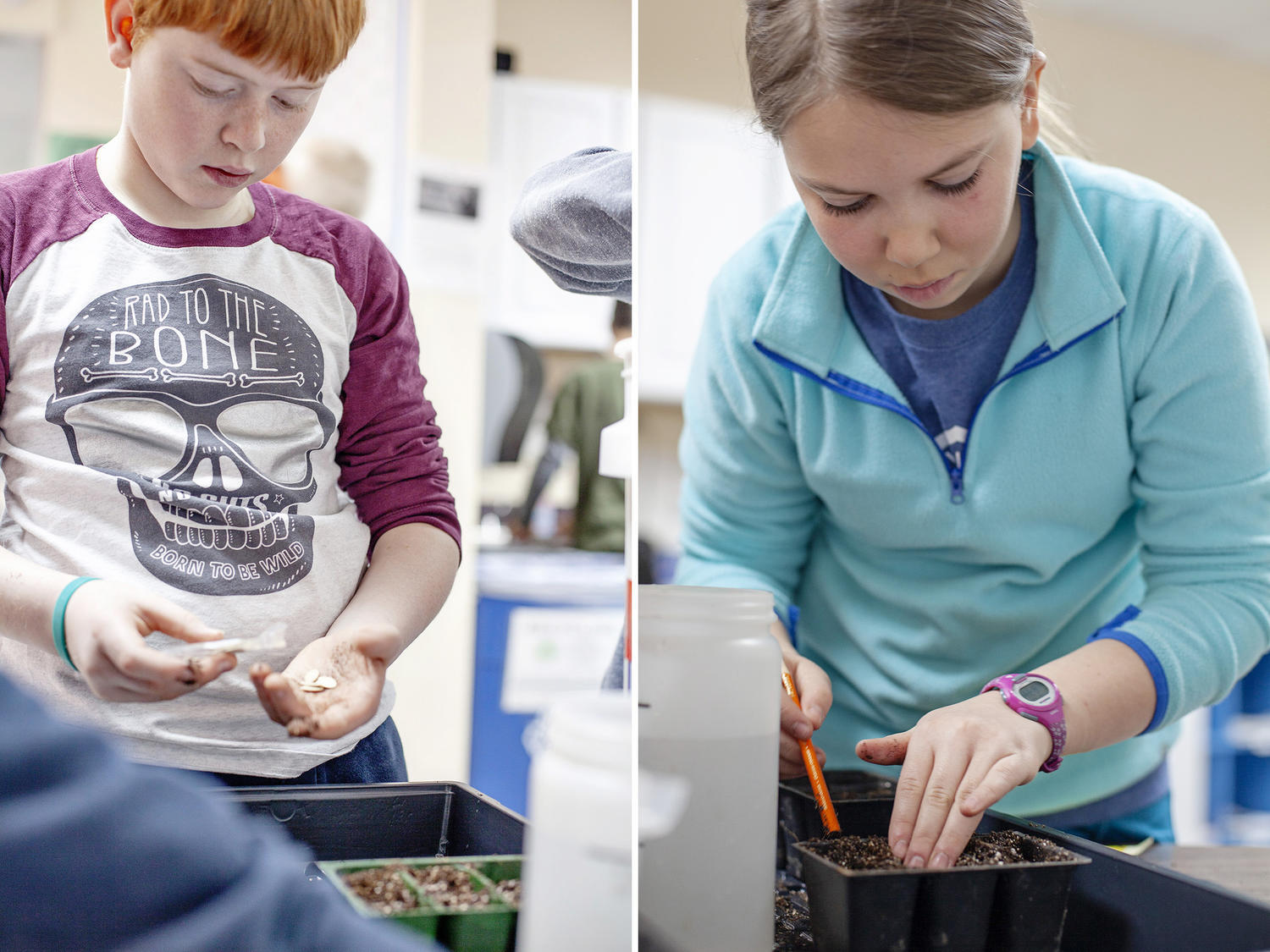The morning after his kindergarten class planted sunflower seeds, Liam M. ’31 ran off the bus and into the classroom to find the cup that held his seed. He bent over and whispered, “I love you, little seed. You’re the best little seed in the whole world.”
Sparking that connection and curiosity with nature is the goal behind The Colorado Springs School’s new Adopt-a-Crop program.
Students in the Children’s School voted as a class on which crops they wished to plant. Then they were matched up with one to two crops of their choice. Students planted starter seeds in their classrooms in the spring and helped care for them until they were transplanted to the garden near the athletic fields.
If all goes well, students will harvest what they planted when they return in the fall next school year. “That will be fun,” 4th grader Garrett H. ’27 said. “I’m looking forward to that.”
Upper School Science Teacher Natalie Hanson spearheaded the program because she sees an immense value in a school garden for a number of reasons.
“Getting the kids outside in the fresh air and getting their hands in the dirt is very beneficial to their physical health and their emotional health,” she said. “They develop an understanding of where our food comes from and how it’s grown.”
And children involved with growing food also learn about a healthy lifestyle. “There’s a strong nutritional connection because when kids start to appreciate that they grew a carrot, they want to eat that carrot,” Hanson said. “They’re more inclined to want to eat carrots in the future.”
Students planted a variety of crops, including pumpkins, zucchini, yellow squash, tomatoes, basil and peppers. “It’s pretty cool that we’re growing food on campus,” 4th grader Langley F. ’27 said.
While 2nd graders planted watermelon seedlings in the garden, teacher Lori de Juan asked if anyone knew how long it takes a seed to grow into a watermelon. “A year?” one student asked. More like a few months, de Juan shared. The children were shown how deep to dig holes and how much water to give. “I’m so happy with my plant,” 2nd grader Kristen L. ’29 said.
Hands-on experience with a garden helps solidify a child’s connection with food in a way that can’t be taught from a book, said CSS alumna Sarah Hamilton ’11, who owns and operates New Roots Farm in Canon City. Hamilton, who grew up around farming, was a Boettcher Scholar who graduated from Colorado College before opening New Roots. Her farm has hosted CSS Middle School and Upper School Learning Service days and more recently a Senior Capstone project.
“Growing food gives a better sense of interconnectedness because you see how you need the water to grow the seeds. You see the worms in the garden and the role they play. You see the role you play in the garden to produce this most basic element we need to survive, which is food,” she said. “When they see every step of the process, it becomes more exciting when they get to pull that food out of the ground and eat it. They’re so excited to eat it since they grew it.”
While PreKindergartener Mayla B. ’32 didn’t care much for the feel of dirt while planting carrots in the CSS garden, she told her mom that she loved putting her seed in the ground and watering it. And that is a step toward her bonding with food and how it is grown.
“Once kids have a connection, they’ll feel an obligation to protect all of the resources that go into growing it,” Hamilton said. “We’re just so disconnected to our food as a society in a way that I think people historically have never been before. Kids think milk grows in cartons and carrots come from grocery store shelves. They don’t understand what it takes to produce food. If they don’t have an appreciation for healthy food, they’re more likely to choose a bag of chips than a fresh vegetable.”
When Hamilton was a high school student at CSS, she and other classmates started the garden by building boxes and planting. They didn’t harvest many vegetables. It took awhile for the concept to catch on especially since tending the garden mainly happened during the summer months when students were away. Over the years, various volunteers and student groups, including Middle School Seminar and Community Service Days, have reinvigorated the garden and added elements such as raised garden beds.
Most recently, a few Upper School students built the compost bin for the Adopt-a-Crop program, the first of its kind offered at CSS to the Children’s School. An aspiration is to produce enough harvest that can be used for school lunches. Hanson hopes students of all ages learn the concept of sustainability through the program.
“If we can raise more of our food locally, we’re cutting down on our carbon footprint by not having to ship foods,” Hanson said. “We’re doing it organically, so there’s no artificially synthesized pesticides or fertilizers.”
Fourth grade teacher Sara Derr says the school garden goes beyond students learning about growing food. “It also teaches you to do something and do your best and hope it works. You hope there’s not a hail storm. You hope they get enough water,” Derr said. “It can be a great lesson in disappointment, as well as success.”
CSS families interested in watering the garden during the summer or donating materials (such as wood chip mulch, compost, gardening tools, frost and hail covers, and specific building supplies) may contact Hanson by email at nhanson@css.org.














